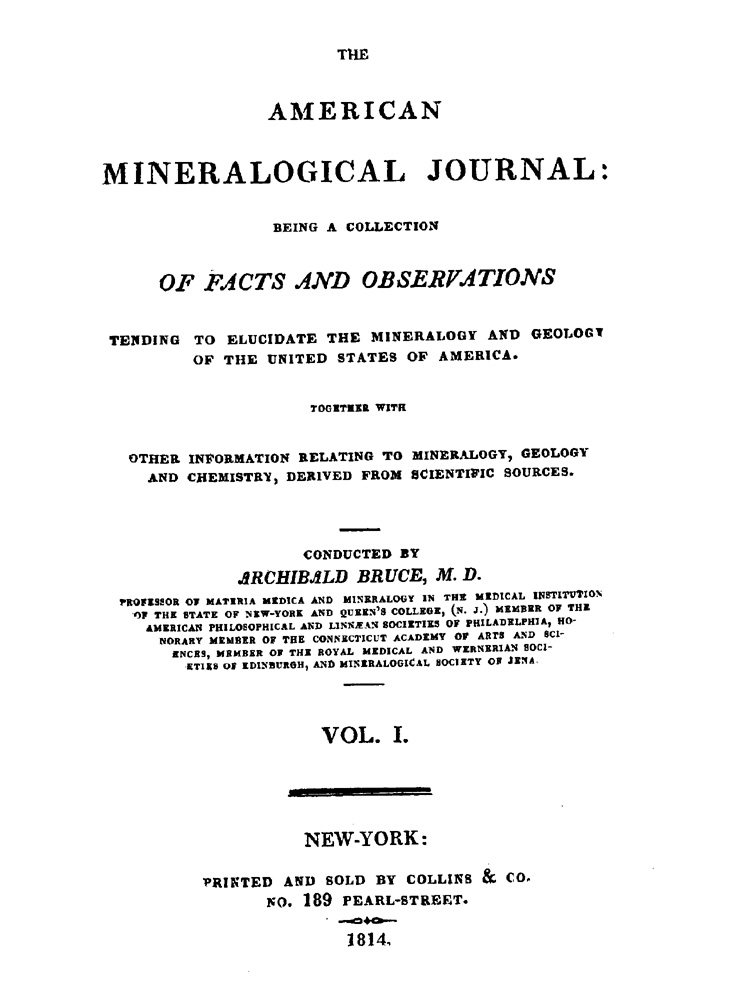AMERICAN MINERALOGICAL JOURNAL.
(1814 – 1814)

1. English, 1814 [Periodical].
The | American | Mineralogical Journal: | being a collection | of facts and observations | tending to elucidate the mineralogy and geology | of The United States of America. | Together with | other information relating to mineralogy, geology | and chemistry, derived from scientific sources. | [rule] | Conducted by | Archibald Bruce, M.D. | Professor of materia medica and mineralogy in the medical institution | of the state of New-York and Queen's College, (N.J.) Member of the | American Philosophical and Linnæan societies of Philadelphia, Ho- | norary member of the Connecticut Academy of Arts and Sci- | ences, Member of the Royal Medical and Wernerian Soci- | eties of Edinburgh, and Mineralogical Society of Jena. | [rule] | Vol. I. | [double rule] | New-York: | Printed and sold by Collins & Co. | No. 189 Pearl-Street. | [ornate rule] | 1814.
8°: π3 A-Ll4 Mm1; 138l.; [i]-vi, [1]-270, [2] p., 2 plates, text diagrams. Page size: 186 x 120 mm.
Contents: [i-ii], Title page, verso "District of New-York ..."; [iii], "The object of this work is to collect and record | ..."; [iv], Blank.; [v]-vi, "Contents."; [1]-270, Text.; [2 pgs], "Index."
Rare. Edited by Archibald Bruce [see note below], The American Mineralogical Journal was the first periodical in America devoted exclusively to scientific subjects. Although its existence was short lived, from 1810 to 1814, it was recognized early in its history to give reliable information about the mineral deposits and recently discovered geological phenomena of America. In 1814 the four issues already published were collected together into a single volume. Then due to Bruce's deteriorating health, publication ceased, although the editor optimistically believed that his Journal would someday continue. Unfortunately, he never regained sufficient strength to resume his editorial duties and only after his death in 1818, was his vision realized. This new magazine edited by Bruce's good friend Benjamin Silliman of Yale increased its format to include all forms of science, including mineralogy and geology, and thus became the oracle for nineteenth century American science. The title it took on its debut in 1818 was: The American Journal of Science, More Especially of Mineralogy, Geology, and the Other Branches of Natural History; Including Also Agriculture and the Ornamental as well as the Useful Arts.
Facsimile reprint, 1968: The | American | Mineralogical Journal | Conducted by | Archibald Bruce, M.D. | Volume I | (Facsimile of the 1814 Edition) | Introduction by | John C. Greene | University of Connecticut | Forward by | George W. White | University of Illinois | [ornament] | Hafner Publishing Company, Inc. | New York and London | 1968. 8°: [2], [i]-xvii, [2] blanks, [1] portrait of Bruce, [i]-vi, [1]-270, [2] index p. Published as the first volume of Contributions to the History of Geology, edited by George W. White.
Archibald Bruce. (Born: New York City, New York, U.S.A., February 1777; Died: New York City, New York, U.S.A., 22 February 1818) American chemist & mineralogist. Bruce's father was head of the medical department of the British Army stationed in New York City. He was educated at a boarding school on Long Island before entering Columbia College in 1791, receiving his A.B. degree in medicine in 1797. One of medical professor's was David Hosack who had returned from Europe with a substantial mineral collection. Soon, Hosack infected Bruce with his enthusiasm for minerals, which quickly became Bruce's favorite leisurely pursuit. In 1798, Bruce sailed for Great Britain to study medicine at the University of Edinburgh. He was awarded the degree of M.D. in 1800, after which he toured France, Switzerland, Italy and England. During this tour, he became acquainted with all of the leading mineralogists of France and England. In 1803, he married in London and returned to America, where he opened a successful medical practice. In 1807, Bruce and several others founded the College of Physicians and Surgeons, now Columbia University's Medical School. In this venture Bruce was a trustee, 1807-11, registrar, 1807-11, professor of mineralogy, 1807-8 and professor of materia medica, 1808-11. In 1812, Bruce and others again founded a new medical school associated with Rutgers. There he was professor of mineralogy and materia medica, 1812-8. He died of apoplexy in 1818. Bruce's mineral collection sold for the large sum (in that time) of $5,000, which indicates a high quality of specimen. His name is perpetuated by the mineral "Brucite" named in his honor by F.S. Beudant in 1819.
Bibliographical references: BMC: 1, 38. • Edinburgh Review: 17, 114-21. • Greene & Burke, Minerals in the Age of Jefferson, 1978: 55-9. • LKG: V 42. • Merrill, History of American Geology, 1906: 223-4. • White, Essays on History of Geology, 1968: vii. (Bruce) American Chemists & Chemical Engineers: 2, 33-4 [by W.D. Miles]. • American Journal of Science: 1st Series, 1 (1819), 299-304, portrait [by B. Silliman, Sr.]. • Meisel, American Natural History, 1924-9: 2, 125-8. • Poggendorff: 1, col. 311.
.